#cosmic crustacean
Explore tagged Tumblr posts
Text
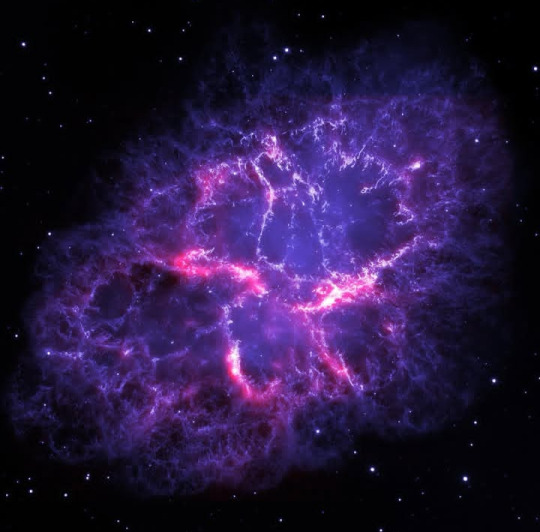
"A cosmic crustacean."
The Crab Nebula
Credit: https://www.instagram.com/share/p/BAWM2O1pS3
#space#the crab nebula#nebula#cosmos#astronomy#stars#star#universe#galaxy#milky way#solar system#nasa#sky#cosmic crustacean
89 notes
·
View notes
Text


Isopod - Kid Cosmic S2E4
18 notes
·
View notes
Text

Fascinating.
Wait.
Haven’t I seen this somewhere before?
Hmmm….
Yeah this sounds oddly familiar to me.
Hang on.
…
Oh…
Oh no….
Oh this is BAD!
I think we ought to keep that little fella inside the amber.
For good.
#dougie rambles#personal stuff#my poor attempt at a joke#oh no#the horrors#cosmic horror#this sounded funnier in my head#halo#microsoft#gaming#343 industries#halo studios#crab#crabs#crustacean#prehistoric#amber#trapped in amber#preserved#cretaceous period#shitpost#primordial#precursors#oh jesus#sweetness#the flood#the Atlantic abomination
13 notes
·
View notes
Text
Round 2 - Arthropoda - Branchiopoda

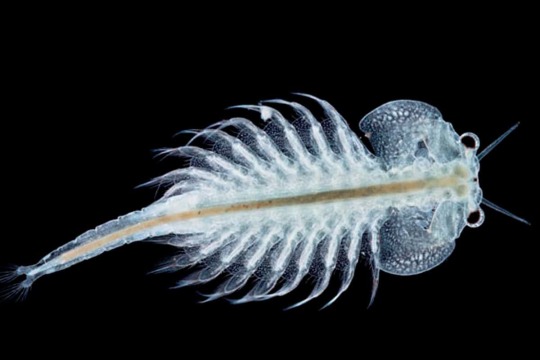
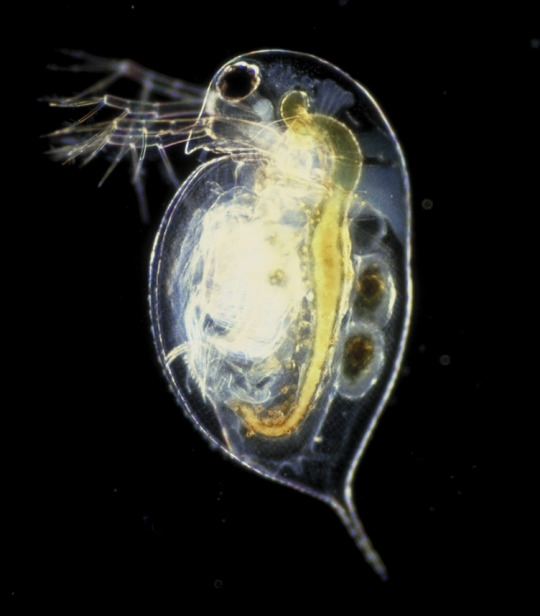

(Sources - 1, 2, 3, 4)
Branchiopoda is a class of small, mainly freshwater crustaceans that feed on plankton and detritus. They are comprised of 9 orders: Anostraca (“Fairy Shrimp”), Anomopoda (“Water Fleas”), Ctenopoda (also “Water Fleas”), Cyclestherida (“Clam Shrimp”), Laevicaudata (also “Clam Shrimp”), Spinicaudata (also “Clam Shrimp”), Haplopoda (“Predatory Water Fleas”), Onychopoda (“Water Fleas” again), and Notostraca (“Tadpole/Shield Shrimp”).
Branchiopods are found mainly in freshwater, including temporary pools and hypersaline lakes, and some in brackish water. Those that live in temporary pools are known for having eggs that can dry out for long periods of time and hatch once they are submerged in water, as an adaptation to drought. Only two families, one in Onychopoda and one in Ctenopoda, contain marine species. Most eat detritus or plankton, catching them in the setae on their appendages. Notostracans are opportunistic omnivores that will feed on algae, bacteria, other branchiopods like Anostracans, and even small fish.
Branchiopods are characterized by the presence of gills on many of the animals’ appendages, including the mouthparts. Most have compound eyes and a carapace. In the Clam Shrimp, the carapace prevents the use of the legs for swimming, so the antennae are used for locomotion instead, as they are in nauplius larvae.
The oldest known branchiopod was Rehbachiella kinnekullensis of the Upper Cambrian. Notostracans in particular have a good fossil record, with the oldest known species being Strudops goldenbergi from the Late Devonian. Notostracans are often described as “Living Fossils” due to their lack of major morphological change over 250 million years.
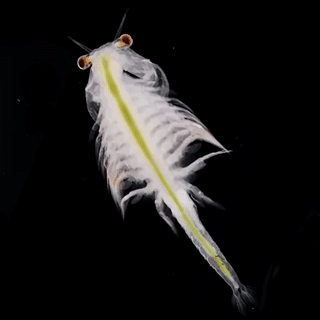
Propaganda under the cut:
Both Triops (a genus of Notostracan) and Artemia (a genus of Anostracan) make popular low maintenance aquarium pets, respectively called “Dinosaur Shrimp” and “Sea-monkeys” in the pet trade.
Triops longicaudatus helps control the West Nile virus, as they prey on Culex mosquito larvae.
In Japan, Triops cancriformis are used as biological pest control, kept in rice paddies to eat weeds.
Most branchiopods feed on small plankton and detritus, but some are large(r) predators, and Notostracans aren’t the only ones! The Giant Fairy Shrimp (Branchinecta gigas) can get up to 86 mm (3.4 in) long, lives in hypersaline lakes and rivers, and eats copepods and other branchiopods: mainly other fairy shrimp.
The genus Artemia, also known as Brine Shrimp, are commonly bred to feed fish and crustacean larvae, both in fish farms and in aquarium tanks, due to their ease of rearing, richness in nutrients, and tendency to be the preferred snack of small fish. Daphnia, a genus of Anomopod, are also often bred as fish food, as well as for amphibian larvae.
Artemia urmiana was once abundant in Lake Urmia of Iran, but drought has caused their population to drastically decline, leading to fears that they were nearly extinct. However, a second population has been discovered in Koyashskoye Salt Lake of Ukraine, giving hope for their recovery.
Scientists have taken the eggs of Artemia salina to outer space to test the impact of radiation on life. The brine shrimp eggs traveled on U.S. Biosatellite 2, Apollo 16, and Apollo 17 missions, and on the Russian Bion-3 (Cosmos 782), Bion-5 (Cosmos 1129), Foton 10, and Foton 11 flights. On Apollo 16 and Apollo 17, the cysts traveled to the Moon and back. Unfortunately, the results showed A. salina eggs are highly sensitive to cosmic radiation… 90% of the embryos died at different developmental stages.
Clam shrimp convergently evolved a shell similar to a bivalve. Both valves of the shell are held together by a strong closing muscle. The animals react to danger by contracting the muscle so that the valves close tightly and the crustacean floats motionlessly to the bottom of the water.
Daphnia are used in scientific studies as a model organism. Because they are nearly transparent, their internal organs are easy to study in live specimens. They are often used to test the effects of toxins and climate change, assisting with the assessment of ecological impacts caused by human disturbance.
One time, while looking at pond water under microscope, I saw a Chydorus sphaericus and squealed out loud cause it was so cute, and my professor made fun of me. But look at this. The Cheat lookin ass:
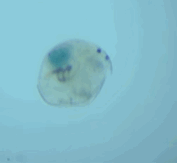
#round 2#animal polls#arthropoda#i love Triops and I always wanted some and even got as far as getting some eggs for my birthday as a kid and then just uh#never put them in water#i wonder if they would still hatch it’s been like 20 years…#Branchiopoda
71 notes
·
View notes
Text
Fandorm Showcase #21 - Treasure Planet
TWST, please make events based on more obscure Disney movies, and my life will be yours-
Introducing the adventurous and courageous dorm inspired by Treasure Planet...
Terraider!

Terraider combines the words, Terra and Raider.
This dorm focuses on adventure and taking chances, challenging things that one has never done before in their lifetime. Although this is a very dangerous mindset to have in general, Terraider has no fear whatsoever, thinking that by challenging the risks, they can overcome that fear. They also have a knack in tinkering with machinery, specifically magic-powered technology, building various gadgets for their adventures like solar-powered hoverboards and hologram projection spheres.
"A dorm founded on the Cosmic Corsair's spirit of audacity. Students in this dorm are willing to take risks and chances in risky situations to overcome any obstacles."
Requirements and Traits:
Willing to take risks
Have a spirit for adventure
Knowledgeable in machine tinkering
Dorm Uniform Design:

This one, I wanted to make it unique in a way, since the character the dorm leader is based off is a cyborg. Instead of your usual silver robotic parts, I made the cyborg parts copper/bronze to reflect the rustic/steampunk-esque style of the movie. The magic item, being a drone-like orb that can split apart its panels, would dock onto the mechanical shoulder area to be used as a magic sentry of sorts, which can also be concealed under the draped coat.
Character Roster:

Say ahoy to the adventurous and audacious captain and dorm leader of Terraider...
Suilven J. Tresor! (Twisted off John Silver)

Suilven J. Tresor is the embodiment of rugged charisma and cunning ambition, a man of contradictions who walks the line between rogue and mentor. With his hearty laugh, booming voice, and ever-present grin, Suilven seems like the kind of person who’s always ready to share a tall tale or offer a helping hand. But beneath his jovial exterior lies a sharp mind and a relentless drive to carve out his own fortune.
Suilven is a natural leader, able to inspire loyalty and trust with his magnetic personality and genuine moments of kindness. He's the kind of person who can turn a chaotic situation into an opportunity, using quick thinking and resourcefulness to stay one step ahead. However, his motivations are often self-serving, and he’s not above bending the rules or engaging in underhanded tactics to get what he wants.
Though he has a rough-and-tumble demeanor, Suilven has a softer side that he rarely shows. He has a deep respect for those with potential and a fierce protective streak for the people he cares about, mainly his dorm members of Terraider as their sophomore housewarden. His past is a patchwork of triumphs and betrayals, and he carries the weight of his choices with a mix of pride and regret. This duality makes him both inspiring and intimidating—a man who knows what it means to chase dreams while walking the knife’s edge of morality.
Notable Members:
Allard Kaempferi (Sophomore) - A sly and ruthless arachnid/crustacean beastfolk who is distrustful of others and tends to use carefully-worded manipulation to wear one's confidence down a peg. (Twisted off Scroop)
Phymor Synth (Freshman) - A lively and mischievious trickster who often shifts his appearance to fool others for fun, but he has trouble maintaining his identity at times, sometimes forgetting how he looked like. (Twisted off Morph)
Synopsis:
An ancient treasure map was suddenly found in the deep archives of the Night Raven College library, which sparked the interest of Suilven J. Tresor, the housewarden of Terraider. He is on a personal quest to track down this supposed treasure, with the support of his dorm members. But one member in particular, Allard Kaempferi had other plans to make sure things go his way...
Next Up: Atlantis The Lost Empire
24 notes
·
View notes
Photo
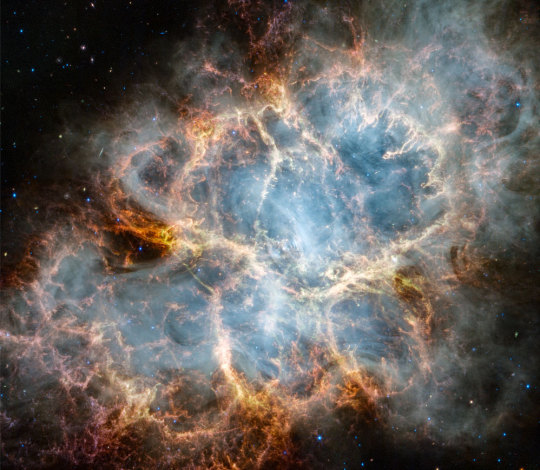
2023 November 15
M1: The Incredible Expanding Crab Image Credit: NASA, ESA, CSA, STScI; Jeff Hester (ASU), Allison Loll (ASU), Tea Temim (Princeton University)
Explanation: Cataloged as M1, the Crab Nebula is the first on Charles Messier's famous list of things which are not comets. In fact, the Crab Nebula is now known to be a supernova remnant, an expanding cloud of debris from the death explosion of a massive star. The violent birth of the Crab was witnessed by astronomers in the year 1054. Roughly 10 light-years across, the nebula is still expanding at a rate of about 1,500 kilometers per second. You can see the expansion by comparing these sharp images from the Hubble Space Telescope and James Webb Space Telescope. The Crab's dynamic, fragmented filaments were captured in visible light by Hubble in 2005 and Webb in infrared light in 2023. This cosmic crustacean lies about 6,500 light-years away in the constellation Taurus.
∞ Source: apod.nasa.gov/apod/ap231115.html
150 notes
·
View notes
Text
There is a type of person occasionally seen in these neighborhoods who has connections with junk, though he is neither a user nor a seller. But when you see him the dowser wand twitches. Junk is close. His place of origin is in the Near East, probably Egypt. He has a large straight nose. His lips are thin and purple-blue like the lips of a penis. Thee skin is tight and smooth over his face. He is basically obscene beyond any possible vile act or practice. He has the mark of a certain trade or occupation that not longer exists. If junk were gone from the earth, there might still be junkies standing around in junk neighborhoods feeling the lack, vague and persistent, a pale ghost of junk sickness.
So this man walks around in the places where he once exercised his obsolete and unthinkable trade. But he is unperturbed. His eyes are black with an insects unseeing calm. He looks as if he nourished himself on honey and Levantine syrups that he sucks up through a sort of proboscis.
What is his lost trade? Definitely of a servant class and something to do with the dead, though he is not an embalmer. Perhaps he stores something in his body - a substance to prolong life - of which he is periodically milked by his masters. He is as specialized as an insect, for the performance of some inconceivably vile functions
...
I got drunk on the fifty pesos. About nine that night, I ran out of money and went back to my apartment. I lay down and tried to sleep. When i closed my eyes I saw an oriental face, the lips and nose eaten away by disease. The disease spread, melting the face into an amoeboid mass in which the eyes floated, dull crustacean eyes. Slowly a new face formed around the eyes. A series of face, hieroglyphs, distorted and leading to final place where the human road ends, where the human form can no longer contain the crustacean horror that has grown inside it
...
I was sitting in Lola's reading the papers. After a while I put the paper down and looked around. At the next table somebody was talking about the lobotomy. "They sever the nerves." At another table two young men were trying to make time with some Mexican girls. "Mi amgio es muy muy . . ." He was looking for a word. The girls giggled. The conversations had a nightmare flatness, talking dice spilled in the tube metal chairs, human aggregates disintegrating in cosmic inanity, random events in a dying universe where everything is exactly what it appears to be, and no other relation than juxtaposition is possible
Three particularly evocative and surreal sections from Burroughs' Junky
23 notes
·
View notes
Text
A couple months ago I tried to make a Godzilla AU centered around the idea "what if the Oxygen Destroyer, rather than killing him, mutated Godzilla further like it did to Destoroyah". It was to take the form of a literature anthology that described each Kaiju in the AU in an SCP type format and how they interacted with Godzilla. While it's unfinished, you can definitely gather which monsters I had ideas for.
I eventually scrapped it because I felt like it was too similar to Black Mass and Shin Godzilla that it came off as a rip off of the two, and I don't like treading the exact same ground as other creators unless I believe I can bring something new to the table. Unfortunately, it mainly boiled down to "Hey look at this Godzilla character! Now they're an irradiated version of a known dinosaur! Godzilla just ate them and absorbed their DNA!" which never amounted to anything other than possible body horror since Godzilla, in my mind, literally swallowed them whole like Orga in Godzilla 2000.
However while it is canceled I don't want it to just rot away on some Google Document. So below is what was written down for the "God Destroyer Godzilla AU" as I've decided to call it.
SND
An SND (short for Sentient Natural Disaster) is a sentient animal, creature, being, or entity that’s able to cause natural disaster level destruction by itself, usually by being of immense size. Classifications are the acronym followed by its scientific name, epithets are the most common nicknames given to it by the general public. Hazard levels include Regional (threat to locals), Continental (threat to multiple countries), Global (threat to the entire planet), and Cosmic (threat to multiple planets).
Gojira
Classification: SND Kujirasaurus
Epithet: Gojira, misheard as “Godzilla” in English
Species: Irradiated Spinosaurus with Whale DNA, later contained Amphibian, Crustacean, Ankylosaurus, Tritylodontidae, Maiopatagium, Mongolarachne, and Pterodactyl DNA
Age: 93 million years existing, 46 years alive
Hazard Level: Continental
Description: Kujirasaurus was the first discovered Sentient Natural Disaster created from the corpse of a Spinosaurus irradiated by atomic bomb testing mixed with whale DNA. As a result of the added whale mass and the radiation, its arms grew longer and bulkier, its scales blackened, its face became more round and blocky, its eyes started bulging out more, it started standing more upright, and its dorsal plate was split into multiple smaller plates reaching from the tip of its tail to the upper neck. It was first sighted by fishermen in the Pacific ocean before it started its rampage through Japan which eventually ended in it returning to the ocean. This would continue on and off for the next couple of days before Dr. Daisuke Serizawa developed an unknown weapon that he believed would terminate Kujirasaurus. He activated the weapon while both he and Kujirasaurus were in the same area of water, sacrificing himself in order to execute the beast.
It was first thought that this worked when it didn’t rise from the water, however the next day it reappeared to continue its rampage. The weapon only seemed to mutate Kujirasaurus further, adding recently deceased Amphibian and Crustacean DNA to its mass.
#godzilla#fangoji#fan goji#fan godzilla#kajju#godzilla au#destoroyah#black mass#shin godzilla#tokusatsu#scp#a broccwalker original#god destroyer godzilla au
10 notes
·
View notes
Text
so i saw a post floating around about like "i bet octopus body/cosmic horror is all about rigid limbs and hinged joints" and my immediate thought was 'but that sums up crustaceans pretty nicely, which octopuses both encounter in their day to day life and find delicious' so i guess that's the kind of nerd i am. anyway that got me thinking about what kinds of literary genres a species of solitary predators would have and my opinions are as follows:
hunting/feeding stories
acquisition stories
i would have said pornography but octopuses die shortly after mating, so maybe not actually
i actually think that their equivalent of horror stories would be anger stories. theyre all about a guy or situation to get mad at
29 notes
·
View notes
Text
Every Dredge Aberration (2024) , Part 12

Twisting tendrils thwarted, then followed down,
by the flotsam’s single-minded greed.
Unyielding until they have found what they need,
so very soon they too, can feed
on nature distorted and innocence drowned. ₊˚.༄
Crown of Nadir
Encyclopedia #169
Aberrant form of crown of thorns
Description:
A fractal gateway, reaching beyond the abyss. From its maw whispers a call from below.

Comment: It resembles uncomfortably the crab pot boon from one of the shrines- Mouth of the Deep. Perhaps one of these was involved in its construction. Despite this creature's association with the water, "Nadir" is a celestial term. In the astronomical sense, it directs to a point on the sphere one stands on directly under the observer's current location. It means below one in the sense of the lowest bottom possible, and taken from the literal Arabic, "opposite". For pondering's sake, if symbolic link from the name “crown of thorns" is to Jesus of Nazareth, ask yourself what more fitting a name could be given to this cosmic perversion than Crown of Nadir? | have no answer, myself.
How to catch: Must be captured by a large enough crab pot. Requires 9 squares of inventory and is only found at depths of 5 meters or shallower in the Basin.
Entangled Crab
Encyclopedia #170
Aberrant form of blue crab
Description:
Glistening purple strings sprout from solid rock, tying and untying themselves. They fall way and whither, making way for new knots.

Comment: Can barely be recognized as the crustacean it supposedly once was. A lovely color of sea spaghetti, at least, and this is a good thing, since the painter will be wanting one towards unlocking the royal purple pigment.

How to catch: Dwells the same depth and areas as the crown of thorns starfish, while only taking up 2 slots, making it suitable for smaller traps if checked frequently.
Imperious Lobster
Encyclopedia #171
Aberrant form of Spiny Lobster
Description:
Iridescent purple feelers recoil from the dry air. Sacs of violet fluid embedded in its carapace begin to drain.

Comment: No answers in sight as to what this fluid is, or its purpose, but there has been discovered a much better function- mixing into a stylish new coat of paint for the fisherman's vessel.

How to catch: A pot catch that actually does not overlap with the zone of the previous two. Place traps between 5 and 50 meters in the Basin.
Mimic slug ˚.༄
Encyclopedia #172
Aberrant form of sea slug
Description:
Foolish morsels of the deep make mistakes they will not live to regret.

Comment: A slug befallen a hideous sort of infection, or an entirely new visitor with a picky selection of prey? Nudibranch often are toxic, or themselves mimics… of their toxic relatives. This makes fairly interesting the theory that this aberrant’s resemblance to these slugs, which try so hard to deter threats with their appearance, is actually meant to draw in their narrow would-be predators, quite possibly the genuine specimens they impersonate. I find amusing though a speculation that there are even stranger Deep dwellers we haven’t yet seen, and how their appetites may crave the promise of danger that most life is wired to fear or find distasteful.
How to catch: The trickster is, ironically enough, easily fooled itself. Any crab pot will do, provided appropriate placement over a tarry patch at sea level to 25 meters of depth.
6 notes
·
View notes
Text
Creature Corner: Vermin part 1

(art by TyhonArt on DeviantArt)
Overview
And here it is, the last creature type of Pathfinder First Edition. This will be the last special in this format, though I’ll probably do a couple of week-long specials on how the creature types developed in Starfinder as well as Pathfinder and Starfinder Second Edition as well, so we’re not quite done. I might even do a special on templates as well.
In any case, let’s get right into it.
Skittering, rustling sounds in abandoned tunnels, the humming flutter of wings carrying a rounded chitinous form, the sudden tugging on your ankle as a previously unseen tentacle drags you down, these are the sensations that often accompany the vermin type, mostly filled with giant bugs and other simple organisms.
But what exactly differentiates creatures of the “vermin” type from the animal type? Back when we did the entries on the animal type, I pointed out that the unifying features of that type were having either a spinal column or having relatively complex brains despite being boneless, but that would be defining vermin by what they are not.
The vermin type consists of insects, arachnids, crustaceans, most mollusks, cniderians, and echinoderms, creatures that range from complex and chitinous to entirely soft-bodied or possessing radial symmetry. It’s a pretty diverse group spanning entire branches of Kingdom Animalia with little to know relationship in some places. Pretty unusual to group them together, honestly.
The vermin type also is noted for usually having the “mindless” trait, meaning they are immune to most mind-affecting effects, including most enchantment spells and certain types of illusions. However, while it’s easy to assume that these creatures truly do act only on instinct, being too “simple” for mental manipulation, complex living things are considerably different than mindless constructs, giant-sized amoeba, and lesser undead. In fact, studies on insect and arachnid behavior has demonstrated many actually have really good memories, being able to recognize individual humans and even demonstrate personalities, so perhaps it’s best to interpret it as the vermin type are far too dissimilar to other minds to use even the broadest enchantments on them.
Perhaps the most unifying thing about the vermin type, however, is that the vermin type is composed of creatures that lack internal skeletons and would be highly unusual and frightening to encounter at massive size.
The idea of giant insects, arachnids, and other vermin has been with us for a very long time, with the first film involving the concept being THEM! In the 50’s, and the first science fiction story involving them being H. G. Wells’ Food of the Gods story back in the 1900’s.
Even before that, regular-sized vermin appear plenty of times in mythology and religion, so even these so-called lesser creatures have their place. It is interesting though that the concept of dialing up their size is so recent though.
Of course, having giant bugs and the like running around begs the question of “why and how”. After all, a lot of you are probably familiar with the “square-cube law”, which when applied to biology, states that the bigger a creature is, the more stress it’s body is under just to not collapse under it’s own weight.
Now obviously in a fantasy setting like Pathfinder, the square-cube law is thrown right out the window off the bat what with all those giant cosmic horrors and literal kaiju and other titanic monsters and literal giants running around, but some still find it a stretch too far without some sort of explanation.
The easiest answer is to say that such giant-sized vermin are just a normal, ubiquitous part of the world. Meanwhile, most science fiction involving them explain it as an extraordinary external factor (typically radiation or some superfood, but in a fantasy setting you can also say magic) that either made giants of that which was miniscule either all at once or generationally. Or maybe the laws of physics are just different in the setting and the square-cube law is more of a suggestion, which isn’t entirely implausible in a setting where “altering reality through sheer force of will” is a part of the metaphysics.
Of course, aquatic vermin like crabs, sea jellies, and the like have somewhat of an excuse with the buoyancy factor, but even they can only go so far before you bump up against and trample over the borders of possibility.
Another factor you run into with giant bugs, and well, any unusually massive creature, is how they affect the food web of their home environments, which also include all sorts of other fantastical beasts, but this is mostly handwaved because it’s fantasy, not a reality simulation.
Moving on from the question of how, let’s talk a bit about the themes that come up with the vermin type. Most are giant-sized versions of bugs and critters both familiar and exotic, while others are just swarms of the regular-sized ones, and others still are fantastical insectoids that don’t quite match any real species but aren’t quite unusual enough to warrant being a magical beast.
As such, the themes of the vermin type are often the horror of being in a situation where you are prey to a creature you’d probably not notice normally, whether they be massive or simply massive in number. While this is true of most, a few vermin also play into other horrific themes as well, such as the xenopterid, which actually mimic a cloaked human before they spread their wings and reveal their clawed legs and move in for the kill.
So while the vermin type does not quite have the variety of concepts beyond Earth’s biodiversity with the photoshop scaling tool applied to it, it still can be a source of fun in it’s own right, as we’ll see as we go through the week. I hope you’re looking forward to it.
8 notes
·
View notes
Text
#bookboost#booksworthreading#aliens and ufos#reader community#scifi#novel#science fiction#book lover#mustread#reading#male reader#female reader#book community#alien invasion#ancient aliens
3 notes
·
View notes
Text

APOD November 15, 2023 M1: The Incredible Expanding Crab Cataloged as M1, the Crab Nebula is the first on Charles Messier's famous list of things which are not comets. In fact, the Crab Nebula is now known to be a supernova remnant, an expanding cloud of debris from the death explosion of a massive star. The violent birth of the Crab was witnessed by astronomers in the year 1054. Roughly 10 light-years across, the nebula is still expanding at a rate of about 1,500 kilometers per second. You can see the expansion by comparing these sharp images from the Hubble Space Telescope and James Webb Space Telescope. The Crab's dynamic, fragmented filaments were captured in visible light by Hubble in 2005 and Webb in infrared light in 2023. This cosmic crustacean lies about 6,500 light-years away in the constellation Taurus.
0 notes
Text
*Trying to make small talk at a bar.* Barnacles are more closely related to butterflies and crabs than they are clams and snails. Kinda fucked up, right? Yeah, they have antennae and everything. I always thought they were mollusks as a kid but they’re not. They’re weird little freaks. They’re arthropods and crustaceans at that. If you ever see barnacles growing on a lobster or a crab, it’s like their lame cousin is hitching a ride with them. I’m scared of barnacles in the cosmic horror way Sherlock Holmes pretended to be worried about bivalves in The Dying Detective. Are you more of a mollusk guy or a crustacean guy? I love them both, can’t pick a side. Do you like Sherlock Holmes?
14K notes
·
View notes
Photo

Cosmic Crustacean - The Crab Nebula [OS][OC] via /r/spaceporn https://ift.tt/3e1P3th
0 notes
Text
carcinisation - an example of convergent evolution in which a crustacean evolves into a crab-like form from a non-crab-like form. The term was introduced into evolutionary biology by L. A. Borradaile, who described it as "one of the many attempts of Nature to evolve a crab" 🦀🦀🦀
OK SO
i want this to be a thing on a universal scale, not just confined to earth. bc that would mean CRAB ALIENS which sounds very fun pls someone draw me a cosmic crustacean
4 notes
·
View notes